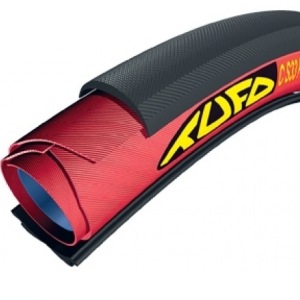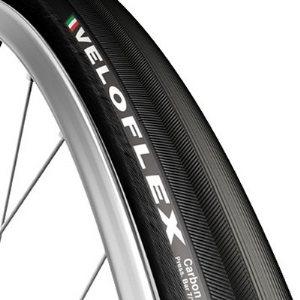
You may have noticed that there was a recent tire poll asking Slowtwitch readers which brand of tire they intend to purchase next. Needless to say, the results were interesting. Out of 660 votes, not one person chose Dugast. More interesting, though, is that a total of 29 votes were spread amongst Dugast, Schwalbe, Vredestein, Hutchinson, and Veloflex. Why are we so shocked? Those are some really great tires! A few are arguably your best possible choices.
Continental, Vittoria, and Michelin were the stand-out winners of the poll. We aren’t arguing that they make some very nice products—just that there’s no reason that some of the smaller or lesser-known-in-the-US brands should receive so little attention. How are we so sure of these brands’ credibility, quality, and speed? Just look to our roadie brethren in the ProTour peloton. Sources tell us that there are only seven manufacturers’ tubular tires actually being raced upon: Veloflex, Challenge, Vittoria, Continental, Schwalbe, Dugast, and FMB (with a Challenge-made tread). In the past, Dugast may possibly have been the biggest player on this list. Our suspicion is that they now have their hands plenty full with a seemingly endless demand from the cyclocross world. Selling or giving away hundreds of free tires to ProTour teams might not look so enticing to them these days.
It appears that today, this role is largely being played by Veloflex, as eluded to in Part 2 of this series. A small handful of companies—or rather—manufacturers with factories, are taking care of the vast majority of high-end tire production.
There is a funny trend in the tires being raced at this top level of two-wheeled sport: They’re old. The designs, the tread patterns, the construction methods… are decades-old technology. Sure, materials improve over time, and tweaks happen here and there. But for the most part, a Dugast from today bears much resemblance to the product of 15 years ago, and Clement tires from 30 or 35 years ago. This is clearly a huge departure from what we see in, say, frame or wheel technology, which seem to get updated every six months. Only in the very recent past have we seen some changing trends, with more top-level cyclists riding new clincher designs or experimenting with tubeless clinchers (and this is specific to time trials; we still see near-exclusive use of tubulars for road stages). As the Coefficient of Rolling Resistance (Crr) data shows us, the old-design tubulars—when glued well—are still some of the best performers today in 2012. Of course, for our triathlon purposes, the caveat of being able to change your own flat tire in a timely manner still exists, which gives the nod to clinchers for many of us. However, the point stands that the old stuff ain’t bad stuff, ‘cause it surely is still among the fastest stuff.
Slowtwitch Tire Poll: What tire brand are most likely to use for racing in triathlons?
Michelin 132 / 20 %
Vittoria 173 / 26 %
Contintental 199 / 30 %
Bontrager 52 / 8 %
Challenge 52 / 8 %
Veloflex 6 / 1 %
Hutchinson 4 / 1 %
Vredestein 8 / 1 %
Schwalbe 11 / 2 %
Dugast 0 / 0 %
Other 30 / 4 %
Total Votes: 667
Raw votes are on the left of the hash next to each brand, to the right of the has is the percentage of total votes this tire brand garnered.
Challenged by Challenge
If you really want some new-old technology at its finest, look no further than Challenge. While seemingly a newcomer, industry insiders suggest that they may, in fact, be one of the best. They use labor-intensive handmade construction. They use what appear to be very high quality, high TPI casings. And the treads look to be very similar to some of the old (pre-1990’s) Clement product… those in-the-know will tell you that the old Clements were no less than the bee’s knees. Indeed, the new Challenge product is made in Thailand, which is where Clement moved after being purchased by Pirelli. Pirelli opted to get out of the bicycle tire business, and Clement disappeared for nearly two decades. The timeline shows us it was during this period that Challenge emerged, so we’re just putting two and two together, and invite you to draw your own conclusion. The now reborn Clement brand advertises all-new tread patterns and construction; but we are unaware where they’re made, or if they hold true to the traditional methods.
In typical cycling industry fashion, many of the products we see under different brands are either made in the same factory, or in factories just down the road from one another. Specific to tires, Thailand is a hotbed of production. This is where Lion Tyre is located, who make nearly all of the Vittoria and Vittoria-private-label product. Often times you find that a location rich in knowledge and labor force for a specific product breeds competing factories. Our guess is that this explains why Clement was made in Thailand, and Challenge is today. This practice is also quite common in China and Taiwan, the other two centers of bicycle tire production (and just about every other bicycle part). Competitors often open up shop—quite literally—across the street from one another. Employee turnover and common sense say that trade secrets don’t remain so for very long. Some products are simply re-badged as a different brand, with no “value-add” work done by that retail-marketed brand. However, in some cases, the ‘retail-brand company’ will manufacture a portion of the tire (such as the tread), which is then sent to the factory that assembles the completed tire for them. And this isn’t a bad thing—these multi-supplier tires have been ridden to many, many victories. There’s a good chance the bike sitting in your garage has such tires today.

Tufo
Tufo, as a brand and as a product, is quite interesting. While some tire geeks suggest that Tufo is not your best choice for triathlon, I counter that it depends on your priorities. You cannot argue that they’ve struggled mightily in Crr. However, my personal opinion is that they excel in quality control (i.e. casing shape consistency), and either puncture resistance or light weight, depending which model you choose. They also offer a completely unique tire intended for clincher rims—what they call a “tubular clincher”. It is essentially a tubular tire with a base tape attached to a thick rubber seal, or lip. This seal seats with the hooks of a clincher rim, and is held on via its expansion upon inflation. The upside, they say, is very consistent shape and higher-than-normal mileage. The downside is that if you do puncture, you cannot put a standard tube inside.
Both their tubular and tubular-clincher products are unique to other tires in that they have a bonded butyl insert inside of the tire. Think of it, in a way, like vulcanizing the inside of the tire. All other tubular brands use a stand-alone inner tube that gets sewn inside, but sits relatively ‘loose’ within the completed tire.

The outside of a Tufo tire is vulcanized, al la Continental, which aids in providing the consistent shape. In my past life as a mechanic, Tufos were always one of my favorites to glue. You could get them perfectly dead-straight, and punctures seemed rare (which meant high customer satisfaction). However, as a race-specific tire, it simply doesn’t stack up on the Crr charts. What makes them so good in one area is what kills them in the other. For those who train on tubulars, I argue that there may be no better choice in existence, especially when coupled with an injectable sealant.

Specialized
Similar to what Trek does with their own line of tires (labeled Bontrager), Specialized has been selling a variety of tires for some time. What you may not know about Specialized is that their very first product was not a bicycle—but a tire, that debuted in 1976 (the Specialized Touring Tire). According to Wolf vorm Walde, Director of Tires and Tubes at Specialized, its real breakthrough came in the 1980s with the introduction of its “Turbo” clincher tire. At the time, the term ‘high performance clincher’ was an oxymoron. If you didn’t have tubular tires, you didn’t have much. Specialized sought to change all that; clinchers’ ease of use appealed to a wider audience, and they wanted to capitalize on the opportunity.
Surely it is a smart business decision for large OE’s like Specialized and Trek to be in the tire business—they can spec every single bike they sell with their own branded tire; likely at a greater profit margin than purchasing a Continental or Michelin. The flip side to this coin is that their tires will likely never be specified as original equipment (OE) on any other brand of bike. As well, distribution is limited to their own retailers or distribution channels; your mom-and-pop bike store might simply have no ability to order these tires even if they want to.
This being said, Specialized makes really good road tires that are a worthy option regardless of what bike brand you ride. Their Mondo Open Tubular tire placed second overall in the latest Bike Tech Review listing. They also offer two high-TPI, latex-tubed tubulars, which are ridden by nearly all Specialized-sponsored professional triathletes. Their Armadillo line of tires are reputed to be very puncture resistant, similar to Continental’s 4-Season and Gatorskin series. I personally think we should have a contest for who can have the toughest-sounding tire name. The Concrete? The Atomic-Kevlar-Kryptonite-Whole-Wheat- … clincher?
With all of the old, the new, and the different choices out there, it’s clear that there’s no shortage of options. While there is something to be said for sticking to what you know or have experience with, I encourage you to try something that is new-to-you, even if it is “old” technology, or latest-and-greatest. I still put my bets on tubeless as having the most long-term potential for future growth and performance gain. If the mountain bike world is any indication, it could very well be what we’re all riding in ten years, at least for training.
Speaking of tubeless, some readers’ comments brought to my attention that there is another recently debuted tubeless option from Maxxis, the Padrone. Is this a sign of further investment and increase commitment to road cycling and triathlon from them? It sure looks like it, and it never hurts to have another brand choice in this still-small niche. We look forward to trying this new option out on the road, and perhaps Al Morrison will do us the honor of testing how it rolls. We are still limited in our choices for tubeless racing wheels, barring some of the do-it-yourself conversion kits out there, which we plan to detail in a later article about tire sealants. For now, the wheel availability of tubulars and traditional clinchers continues to expand, so wrap them up in your favorite tube and tire, and race to your heart’s content.


